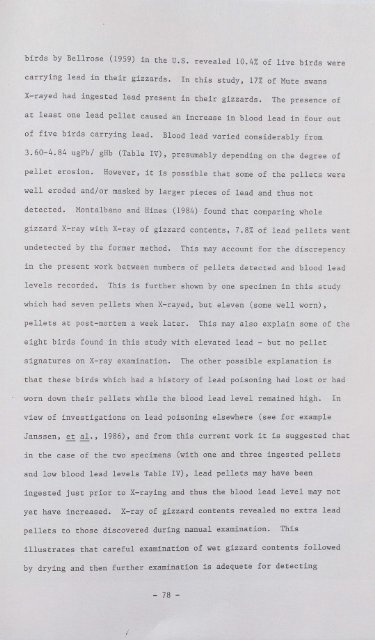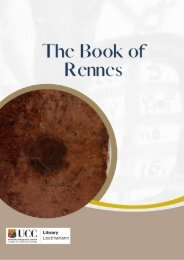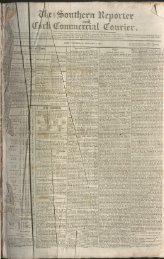Lead Toxicity in Mute Swans
LEAD TOXICITY IN MUTE SWANS Cygnus olor (Gmelin). By JOHN O'HALLORAN A thesis submitted to the National University of Ireland in candidature for the degree of Doctor of Philosophy September 1987
LEAD TOXICITY IN MUTE SWANS
Cygnus olor (Gmelin).
By
JOHN O'HALLORAN
A thesis submitted to the National University of Ireland
in candidature for the degree of Doctor of Philosophy
September 1987
Create successful ePaper yourself
Turn your PDF publications into a flip-book with our unique Google optimized e-Paper software.
irds by Bellrose (1959) <strong>in</strong> the U.S. revealed 10.4% of live birds were<br />
carry<strong>in</strong>g lead <strong>in</strong> their gizzards.<br />
In this study, 17% of <strong>Mute</strong> swans<br />
X-rayed had <strong>in</strong>gested lead present <strong>in</strong> their gizzards.<br />
The presence of<br />
at least one lead pellet caused an <strong>in</strong>crease <strong>in</strong> blood lead <strong>in</strong> four out<br />
of five birds carry<strong>in</strong>g lead.<br />
Blood lead varied considerably from<br />
3.60-4.84 ugPb/ gHb (Table IV), presumably depend<strong>in</strong>g on the degree of<br />
pellet erosion.<br />
However, it is possible that some of the pellets were<br />
well eroded and/or masked by larger pieces of lead and thus not<br />
detected.<br />
Montalbano and H<strong>in</strong>es (1984) found that compar<strong>in</strong>g whole<br />
gizzard X-ray with X-ray of gizzard contents, 7.8% of lead pellets went<br />
undetected by the former method.<br />
This may account for the discrepency<br />
<strong>in</strong> the present work between numbers of pellets detected and blood lead<br />
levels recorded.<br />
This is further shown by one specimen <strong>in</strong> this study<br />
which had seven pellets when X-rayed, but eleven (some well worn),<br />
pellets at post-mortem a week later. This may also expla<strong>in</strong> some of the<br />
eight birds found <strong>in</strong> this study with elevated lead -<br />
but no pellet<br />
signatures on X-ray exam<strong>in</strong>ation.<br />
The other possible explanation is<br />
that these birds which had a history of lead poison<strong>in</strong>g had lost or had<br />
worn down their pellets while the blood lead level rema<strong>in</strong>ed high.<br />
In<br />
view of <strong>in</strong>vestigations on lead poison<strong>in</strong>g elsewhere (see for example<br />
Janssen, et al., 1986), and from this current work it is suggested that<br />
<strong>in</strong> the case of the two specimens (with one and three <strong>in</strong>gested pellets<br />
and low blood lead levels Table IV), lead pellets may have been<br />
<strong>in</strong>gested just prior to X-ray<strong>in</strong>g and thus the blood lead level may not<br />
yet have <strong>in</strong>creased.<br />
X-ray of gizzard contents revealed no extra lead<br />
pellets to those discovered dur<strong>in</strong>g manual exam<strong>in</strong>ation.<br />
This<br />
illustrates that careful exam<strong>in</strong>ation of wet gizzard contents followed<br />
by dry<strong>in</strong>g and then further exam<strong>in</strong>ation is adequete for detect<strong>in</strong>g<br />
- 78 -<br />
I<br />
r
















